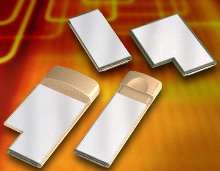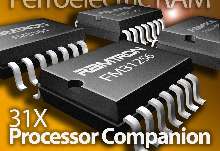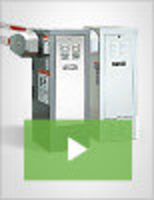Memory Key offers small form factor.
USB 2.0 High Speed Memory Key, a 128 MB flash storage device, enables sharing data between any notebook or desktop system with functional USB 1.1 or 2.0 port. Memory key is thumb-sized, lightweight, and requires no software driver. Partitioning software divides available software into protected and public areas, and write protection prevents accidental overwriting of data.
Read More »
Flash Memory provides data storage for small devices.
Available in both 1.8 and 3 V versions, Models NAND1G and NAND512 offer 1 Gbit and 512 Mbit NAND flash memory. They are organized respectively into total of 32 pages by 4096 and by 8192 nominal blocks that can be read and programmed as a whole. Copy-back program mode enables data stored in one page to be programmed directly into another without external buffering. Each block is specified for...
Read More »PMC Module offers 1 MB of L2 internal cache.
PowerPMC-275 PrPMC offers choice of 1 or 2 PowerPC750GX processors at 1 GHz clock speed. Module implements Marvell Discovery II(TM) system controller that supports multiple Gigabit Ethernet interfaces, integrated DDR-SDRAM memory controller, and PCI 64 bit/66 MHz control plane bus. It features loosely coupled multi-processing support in dual processor mode with single operating system instance....
Read More »Memory Cards offer increased storage capacities.
Suited for video cameras and mobile camera phones requiring high-speed SD memory cards, eFilm Secure Digital (SD) PRO Card is offered in 256 and 512 MB capacities and achieves transfer rates up to 10 MB/s. With 512 MB capacity, card can hold ~4 hr and 20 min of MPEG4 video, 4 hr of MP3 audio, and 1,041 JPEG photos. With capacities of 1 and 2 GB, eFilm CompactFlash (CF) PRO Cards are solid-state...
Read More »
Advantages of VPSA Technology for Your Application
VPSA technology uses different equipment than PSA and requires significantly less energy, resulting in an average cost savings of one-third to one-half in comparison to PSA systems.
Read More »Programmable Module migrates BASIC programs to ControlLogix.
BASIC programmable module for ControlLogix platform enables users to migrate BASIC programs from 1771-DB and 1746-BAS modules to ControlLogix. It features single-slot backplane-compatibility for ControlLogix platform, lets users add BASIC programming with DH-485 and DF1 function calls, and allows users to write programs for specialized applications. BASIC programs are stored in MVI56-BAS Compact...
Read More »
PC Card provides alternative to PCMCIA cards.
Available in 2 sizes, ExpressCard(TM) 34 is approximately half the size of PCMCIA card, and ExpressCard 54 is slightly smaller than standard card. Each measures 5 mm thick, can be fitted with extended backs, and fits into universal slot with one common connector size. Guidance feature ensures proper insertion. Hot-pluggable device has sonically-welded housing and 26-position beam on blade...
Read More »
Processor Companion has 4-256 KB non-volatile FRAM memory.
Processor Companion family offers integrated support and peripheral functions for processor-based systems. Series combines nonvolatile ferroelectric random access memory (FRAM) with real-time clock and processor supervisor, which features programmable low-VDD reset, programmable watchdog timer, and manual reset function. Additional peripherals include nonvolatile event counter, lockable 64-bit...
Read More »Flash Memory targets mobile applications.
Model MT28F644W18 supports I/O voltage of 1.8 V and operates with random access speed of 60 ns and 81 MHz burst frequency. The 64 Mb device offers 4 Mb multi-partitioned architecture, which supports code segmentation. Clock suspend feature allows suspension of burst sequence for retrieval of data from another device on same bus while allowing burst sequence to resume at a later time. Programming...
Read More »Double Data Rate SDRAMs operate at 400 MHz.
With 8-bank architecture, 288 Mb reduced latency DRAM II (RLDRAM(TM) II) products achieve peak bandwidth of 28.8 Gbps using 36-bit interface and 400 MHz system clock. Memory optimizes bus utilization whether data bus is unidirectional or has balanced READ and WRITE ratio. Features include random cycle time of 20 ns, on-die termination, multiplexed or non-multiplexed addressing, and on-chip delay...
Read More »Memory Upgrades offer data transfer rate up to 2,700 MBps.
Series PC2700 CL2.5 Non-Parity DDR Synchronous DRAM SODIMM upgrades are 100% compatible with ThinkPadÃ-® X31, T41, and R50 Series notebook computers. Dual in-line, 200-pin memory modules feature gold-plated leads and include serial presence detect/decode functions.
Read More »
DoorKing's 1601 Lane Barrier Provides a Higher Level of Traffic Control for Less
DoorKing is proud to introduce an easy add-on to its 1601 Barrier Gate Operator: The 1601 Traffic Lane Barrier. The barrier gate provides greater traffic control while eliminating the need for bollards or crash beams. Check out this video to learn more.
Read More »



